
Walt Disney (Tom Hanks) in Disney’s “Saving Mr. Banks”. ©Disney Enterprises, Inc. CR: Francois Duhamel.
By ANGELA DAWSON
Front Row Features
HOLLYWOOD—Beloved actor Tom Hanks adopts the persona of another beloved movie icon—Walt Disney—in the whimsical drama “Saving Mr. Banks.”
Inspired by true events, “Saving Mr. Banks” tells how the motion picture studio founder convinced P.L. Travers, the very reluctant author of “Mary Poppins” to allow her children’s book to be adapted into a movie, which has since become a motion picture classic.
Hanks, a two-time Oscar winner, co-stars alongside two-time Oscar winner Emma Thompson, who plays the cantankerous and cautious P.L. Travers, who finally agreed to Disney’s proposal after a two-week trip to Los Angeles, including a trip to Disneyland.
Hanks, 57, transformed himself physically and vocally for the man known to billions of fans around the world simply as Uncle Walt. He spoke about playing such an iconic character and what he learned about the visionary entrepreneur.
Q: You’re portraying a man with a very high public profile. How did you find the essence of Walt Disney?
Hanks: There is a bit of a vocal cadence and a rhythm Mr. Disney had that took a while to figure out. But a lot of the little anecdotes we found specifically from the likes of (“Mary Poppins” music co-composer) Richard Sherman were already in the screenplay. For example, Walt’s cough. Walt smoked three packs a day, and Richard Sherman said he always knew when Walt was coming to visit his office, because he could hear him coughing by the elevator. So you’re able to put that kind of stuff into it, and it just ends up being one of the delightful cards in the deck.
Q: Could talk a bit about the challenges of playing such iconic character, the research you did, talking to people that knew him, and how that helped you inform your performance?
Hanks: There was a lot of anecdotal information that kept coming to us. There were people who knew Walt, and they still have access to the studio. They still have their (guild) cards that let them onstage. They searched us out. Richard Sherman was a never-ending fountain of stories, facts, and anecdotes of all the bits and pieces of everything that had happened. And Diane Disney Miller, his daughter, gave me unlimited access to the archives and the museum in San Francisco. I made a couple of visits there. So I had a lot of video and audio that I could work with. The only handicap was that a lot of it is Walt Disney playing Walt Disney. But even in some of that and plenty of others, there’s an ocean of cadence to the man, and that true sense that he believed everything that he said about his projects. He completely embraced the possibilities of wonder in the movies that he was going to make as well as the rides he was going to come up with, and the things he was going to build. So I had a great road map in order to search it out.
Q: Both your and Emma’s characters are pretty obsessed with this book. In your own life, is there something that you have just either wanted to do as an actor, or are you obsessed with a book or a character, and hope to turn it into a movie?
Hanks: I always wanted to play Lestrade of Scotland Yard, just because he’s kind of a buffoon that gets to wear a uniform, and I thought, “Well, that would be fun.”
Q: It must have occurred to you this is your second “Saving” movie. Will you do a third “Saving” movie?
Hanks: I like to think of it as a trilogy. There’s got to be some era of history that we can explore. It seems to be moving forward. I’d like to (do) “Saving John DeLorean.” (He laughs.) No, I have no idea.
Q: Your co-star played “Nanny McPhee.” Maybe you could make a sequel to that.
Hanks: I am hoping to make “Saving Nanny McPhee,” which would really be, the way I count it, killing six birds with one stone. That’s what I’m hoping.
Q: You have two grandchildren. Have you taken them to Disneyland, by chance? What is it like to be Tom Hanks as a grandfather?
Hanks: We did go. I took them to Disneyland on the day we shot in Disneyland. An interesting thing happens as a grandparent that you see no reason whatsoever that your granddaughter shouldn’t be delighted to take a ride on the Winnie the Pooh Adventure. It’s Winnie the Pooh. It’s fun. It’s Pooh Bear. It’s Kanga and Roo and Owl. It’s Christopher Robin. It’s going be a blast. She’s going remember this the rest of her life—her ride on Winnie the Pooh’s Great Adventure. My granddaughter was terrified by the noise, the big spinning bears. She’ll be haunted for the rest of her days by this first image of Winnie the Pooh in a loud, short, herky-jerky ride that her grandfather forced her to do on the day he played Walt Disney in Disneyland. That is just a sample of the fantastic job I do as a grandparent.
Q: What have you learned about Walt Disney after making the movie that you didn’t know before? How challenging was it for you to have to look and sound like him?
Hanks: We had the most discussed, photographed, analyzed, diagrammed, tested mustache on the planet. I think actually documents went to United States government to discuss the angle of the shave, how much mustache was going to be there. I don’t look too much like him, but there is a line, an angular figure you can get from, by way of the boxiness of the suits, playing around with various pieces of hair in order to get there. I had a little bit of luck in that. Walt Disney, at this time in his life (that I’m portraying him) was very much already (the iconic) Walt Disney. He was the accomplished artist, industrialist that he was. The surprises came from (his daughter) Diane about how much of a regular dad this guy was. Disneyland itself came about because he used to spend every Saturday with his daughters. After a while, here in L.A., he ran out of places that he could take his daughters. There were pony rides over where the Beverly Center (shopping center) is now, and there was the merry-go-round in Griffith Park, but after that, that was it. He was sitting eating peanuts on a park bench in Griffith Park and the girls were on the merry-go-round, and he said, “God, there really should be a place dads can take their daughters on a Saturday in L.A.” And from that Disneyland was born. So that connection he had through a very tight family. His brother Roy, his mom and dad, were also a part of his life as soon as he had money—that was it. Also, he was, sadly, a victim of the times. He smoked three packs of cigarettes a day and he died of lung cancer. That’s just another one of the grim realities of the day. That’s the way the world operated back then.
Q: As a storyteller who has directed and produced projects, how do you relate with the conflict Mr. Disney had with P.L. Travers? He wanted to tell this marvelous story that he had in his mind, and he has to deal every day with a reluctant author?
Hanks: It starts in your head and you see possibilities for it, and it’s just one **** thing after another. It seems like you’re always coming across somebody like this hell-in-a-gasbag (Travers) that just says, “No! No! No, it’s not going to happen!” Walt Disney, at this point (in his career), was pretty much used to getting his way, because everybody loved him. He’s the guy who invented Mickey Mouse. In the creative process, which is really what this movie is about, you come to loggerheads, and you just have to keep the process moving forward, even if that requires jumping on a plane and flying to London and knocking on hell-in-a-gasbag’s door. It’s just what the creative process requires sometimes, and it’s a good thing it’s fun, otherwise, it’d be too much work.





